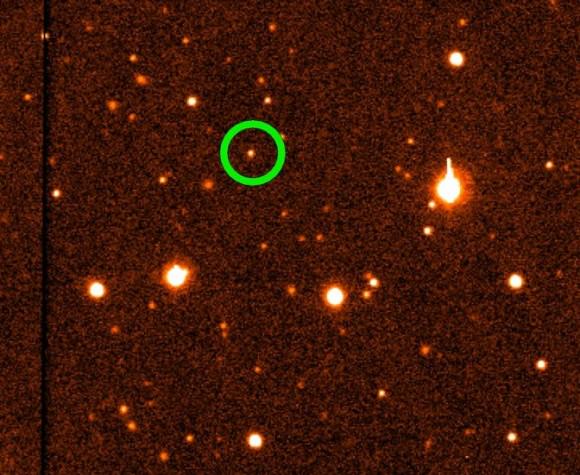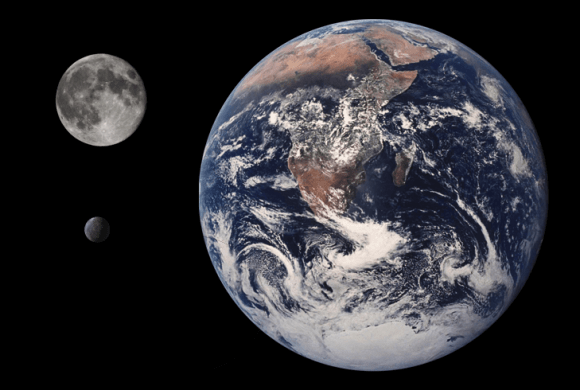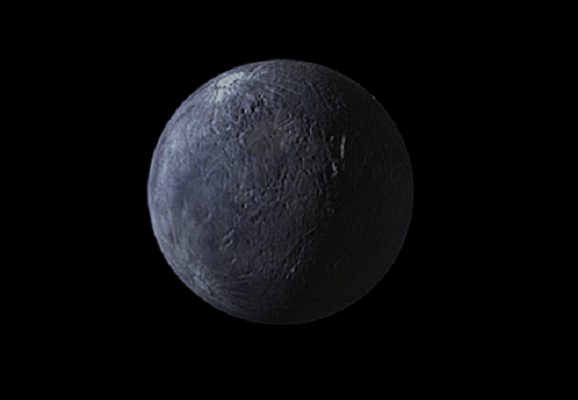Since the early 2000s, more and more objects have been discovered in the outer Solar System that resemble planets. However, until they are officially classified, the terms Kuiper Belt Object (KBO) and Trans-Neptunian Object (TNO) are commonly used. This is certainly true of Orcus, another large object that was spotted in Pluto’s neighborhood about a decade ago.
Although similar in size and orbital characteristics to Pluto, Orcus is Pluto’s opposite in many ways. For this reason, Orcus is often referred to as the “anti-Pluto”, a fact that contributed greatly to the selection of its name. Although Orcus has not yet been officially categorized as a dwarf planet by the IAU, many astronomers agree that it meets all the requirements and will be in the future.
Discovery and Naming:
Orcus was discovered on February 17th, 2004, by Michael Brown of Caltech, Chad Trujillo of the Gemini Observatory, and David Rabinowitz of Yale University. Although discovered using images that were taken in 2004, prerecovery images of Orcus have been identified going back as far as November 8th, 1951.
Provisionally known as 90482 2004 DW, by November 22nd, 2004, the name Orcus was assigned. In accordance with the IAU’s astronomical conventions, objects with a similar size and orbit to that of Pluto are to be named after underworld deities. Therefore, the discovery team suggested the name Orcus, after the Etruscan god of the underworld and the equivalent of the Roman god Pluto.

Size, Mass and Orbit:
Given its distance, estimates of Orcus’ diameter and mass have varied over time. In 2008, observations made using the Spitzer Space Telescope in the far infrared placed its diameter at 958.4 ± 22.9 km. Subsequent observations made in 2013 using the Herschel Space Telescope at submillimeter wavelengths led to similar estimates being made.
In addition, Orcus appears to have an albedo of about 21% to 25%, which may be typical of trans-Neptunian objects approaching the 1000 km diameter range. However, these estimates were based on the assumption that Orcus was a singular object and not part of a system. The discovery of the relatively large satellite Vanth (see below) in 2007 by Brown et al. is likely to change these considerably.
The absolute magnitude of Vanth is estimated to be 4.88, which means that it is about 11 times fainter than Orcus itself. If the albedos of both bodies are the same at 0.23, then the diameter of Orcus would be closer to 892 -942 km, while Vanth would measure about 260 -293 km.
In terms of mass, the Orcus system is estimated to be 6.32 ± 0.05 ×1020 kg, which is about 3.8% the mass of the dwarf planet Eris. How this mass is partitioned between Orcus and Vanth depends of their relative sizes. If Vanth is 1/3rd the diameter Orcus, its mass is likely to be only 3% of the system. However, if it’s diameter is about half that of Orcus, then its mass could be as high as 1/12 of the system, or about 8% of the mass of Orcus.

Much like Pluto, Orcus has a very long orbital period, taking 245.18 years (89552 days) to complete a single rotation around the Sun. It also is in a 2:3 orbital resonance with Neptune and is above the ecliptic during perihelion. In addition, it’s orbit has a similar inclination and eccentricity as Pluto’s – 20.573° to the ecliptic, and 0.227, respectively.
In short, Orcus orbits the Sun at a distance of 30.27 AU (4.53 billion km) at perihelion and 48.07 AU (7.19 billion km) at aphelion. However, Pluto and Orcus are oriented differently. For one, Orcus is at aphelion when Pluto is at perihelion (and vice versa), and the aphelion of Orcus’s orbit points in nearly the opposite direction from Pluto’s. Hence why Orcus is often referred to as the “anti-Pluto”.
Composition:
The density of the primary (and secondary assuming they have the same density) is estimated to be 1.5 g/cm3. In addition, spectroscopic and near-infrared observations have indicated that the surface is neutral in color and shows signs of water. Further infrared observations in 2004 by the European Southern Observatory and the Gemini Observatory indicated the possible presence of water ice and carbonaceous compounds.
This would indicate that Orcus is most likely differentiated between a rocky core and an icy mantle composed of water and methane ices as well as tholins – though not as much as other KBOs which are more reddish in appearance. The water and methane ices are believed to cover no more than 50% and 30% of the surface, respectively – which would mean the proportion of ice on the surface is less than on Charon, but similar to that on Triton.
Another interesting feature on Orcus is the presence of crystalline ice on its surface – which may be an indication of cryovolcanism – and the possible presence of ammonia dissolved in water and/or methane/ethane ices. This would make Orcus quite unique, since ammonia has not been detected on any other TNO or icy satellite of the outer planets (other than Uranus’ moon Miranda).
Moon:
In 2011, Mike Brown and T.A. Suer detected a satellite in orbit of Orcus, based on images taken by the Hubble Space Telescope on November 13th, 2005. The satellite was given the designation S/2005 (90482) before being renamed Vanth on March 30th, 2005. This name was the result of an opinion poll where Mike Brown asked readers of his weekly column to submit their suggestions.
The name Vanth, after the Etruscan goddess who guided the souls of the dead to the underworld, was eventually chosen from among a large pool of submissions, which Brown then submitted to the IAU. The IAU’s Committee for Small Body Nomenclature assessed it and determined it fit with their naming procedures, and officially approved of it in March of 2010.
Vanth orbits Orcus in a nearly face-on circular orbit at a distance of 9030 ± 89 km. It has an eccentricity of about 0.007 and an orbital period of 9.54 days. In terms of how Orcus acquired it, it is not likely that it was the result of a collision with an object, since Vanth’s spectrum is very different from that of its primary.
Therefore, it is much more likely that Vanth is a captured KBO that Orcus acquired in the course of its history. However, it is also possible that Vanth could have originated as a result of rotational fission of the primordial Orcus, which would have rotated much faster billions of years ago than it does now.
Much like most other KBOs, there is much that we still don’t know about Orcus. There are currently no plans for a mission in the near future. But given the growing interest in the region, it would not be surprising at all if future missions to the outer Solar System were to include a flyby of this world. And as we learn more about Orcus’ size, shape and composition, we are likely to see it added to the list of confirmed dwarf planets.
We have many interesting articles on Dwarf Planets, Kuiper Belt Objects, and the Outer Solar System here at Universe Today. Here is What is a Dwarf Planet? and What is the Kuiper Belt?
And be sure to checkout How Many Planets are in the Solar System?, and this article about all the Bright Objects in the Kuiper Belt.
For more information on Orcus, Vanth, check out the Planetary Society’s page on Orcus and Vanth. To learn more about how they were discovered, consult Mike Brown’s Planets.
Astronomy Cast also has a great interview with Mike Brown from Caltech.


What are the chances that Orcus might have a subsurface ocean? It is becoming interesting that so many dwarf planets could potentially harbor these oceans. This could make them a surprising new class of “water worlds” that could be potential locations for microbial life.
Regarding the number of planets in our solar system, readers should also consider other sources, such as the Great Planet Debate at http://gpd.jhuapl.edu/ .
We’ve posted about that many times, usually in the context of “dwarf planet” articles. You ought to know, you complained about most of them 😉
Not sure if your comment refers to my oceans question or my reference for another view on the planet debate.
The references at the end of your articles are consistently biased in favor of Mike Brown and one particular view in the ongoing debate over what a planet is.
Posting Mike Brown’s website info doesn’t seem like a biased approach, considering he was directly responsible for making these discoveries. And my comment was in reference to the Great Planet debate. The controversy is something I refer to in every article about dwarf planets and how the IAU’s definition was not accepted by all. In spite of that, you keep writing to tell me we’re not giving a balanced appraisal of the picture.
The discoveries were actually made by a team, with the other two members being Chad Trujillo and David Rabinowitz. It would be great if you could post links to their writings as well and to those of other planetary scientists who study these objects. Brown’s constant meme of having “killed” Pluto is unprofessional; he also is known to make statements that are not quite accurate, such as his claim that most planetary scientists accept the IAU definition when this is not the case. Your articles are very good at affirming the ongoing debate; it’s the references at the end that could be improved by representing a variety of perspectives.
That is why their names are mentioned in the article. And since neither have websites that contain similar writings – Trujillo’s is minimal and Rabinowitz doesn’t have one – this seems like an entirely moot point.
This is another nail in the coffin of pebble accretion which has trouble explaining the relative abundance of binary Kuiper belt objects with large moons in particularly-stable orbits. Alternatively, binary planetesimals form in a similar way as binary stars: by fragmentation during gravitational instability (GI) due to excess angular momentum. (Nesvorny et al. 2005)
I suggest planetesimals require a stellar or giant planet resonance (pressure dam) against which to compress in-falling material from a protoplanetary disk or debris disk to undergo GI, whereas Bok globules can undergo Jeans instability directly to form stars. So Pluto and Orcus ‘condensed’ in situ against Neptune’s 3:2 resonance, which I suggest occurred from a secondary debris disk which arose from the ashes of the 542 Ma binary spiral-in merger of our former binary brown-dwarf Companion to the Sun, whose asymmetrical merger gave the Companion escape velocity from the Sun. Condensation of a young debris disk explains Pluto’s geologically young surface and Cares’ low crater count, having formed not long before the first trilobites arose.
Nesvorny, Youdin and Richardson, 2005, Formation of Kuiper Belt Binaries by Gravitational Collapse
Always like your stuff, Matt. Concise, descriptive, and most informative!
Thank you, Bryan. More to follow, for sure 😉
Cant wait to read what you have coming next? Salacia, Ixion, Varuna, Varda, and Chaos are all jealous of the PR we have been receiving.
@orcusthedwarf
well, were just about done with dwarf planets and TNOs/KBOs for now. But you never know… 😉
Oh wait, I lied. There’s still 2007 OR10 (aka. Snow White) to address
Animation of the 3:2 resonances Pluto and Orcus have with Neptune.
http://orbitsimulator.com/BA/orcus.gif
I’m still promoting the term “Tombaugh Object.”
I wonder if it’s appropriate to pre-classify things like this in an article title: “Although Orcus has not yet been officially categorized as a dwarf planet by the IAU, many astronomers agree that it meets all the requirements and will be in the future”.
‘Many astronomers’ do not an authoritative body make.
Science does not need an “authoritative body.” Imagine if such a body back in the 1920s decided to resolve the debate over whether the universe consists of one galaxy or many simply by issuing a decree. The only authorities of significance are the data. If we know the mass and size of an object, or at least have a good estimate of them, and these inform us the object likely is in hydrostatic equilibrium, then it is reasonable to conclude that object is a dwarf planet. We don’t see anyone claiming a need for an “authoritative body” to confirm every exoplanet discovered. If, as in some cases, a discovery turns out to be false, subsequent research will indicate that. The same is true for the designation of dwarf planets.
We are really digging these articles out here in the Kuiper Belt, especially the ones about the potential dwarf planets. This is by far the best one yet.
Quaoar,Sedna, Salacia, 2007 OR10, 2002 MS4 and I have been hanging out on the #dwarfplanet watchlist(purgatory) for 9 years. Both Mike Brown and Dr. Tanzalo have said we are almost certainly Dwarf planets. Haumea and Makemake were promoted with less data about them then they have about Quaoar, and I now.
Its not going to hurt the little growing minds of our school children to learn a few extra names, as they are capable.
@orcusthedwarf